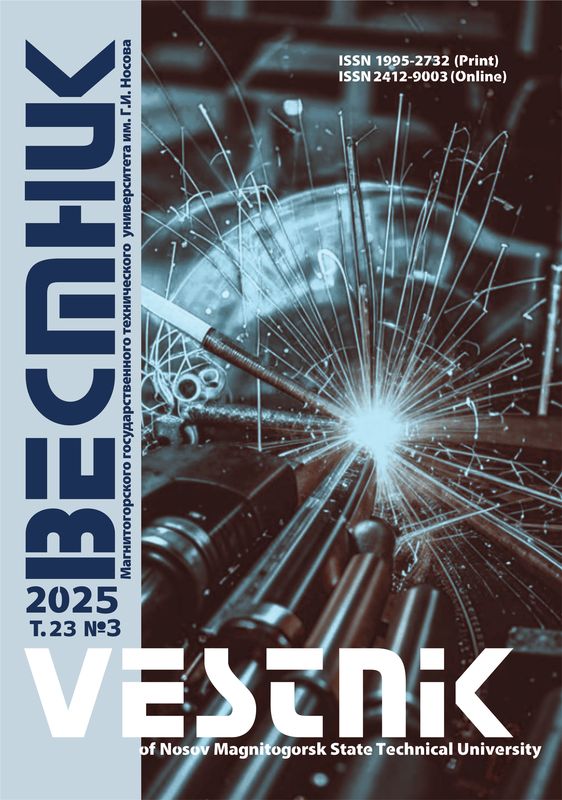DOI: 10.18503/1995-2732-2025-23-2-111-118
Abstract
The relevance of the work is due to the need to develop economically accessible materials that combine high wear resistance, thermal stability, and reliability to replace expensive cobalt-based alloys in the conditions of growing demands of modern industrial production. The objective of the work is a comprehensive thermodynamic modeling of the temperature dependence of phase composition, crystallization, and density changes of high-entropy alloys of the M(Cr30W5C1.5) system (M = Co, Fe, Ni, Al, Mn) to optimize their performance characteristics. The study of how the matrix M composition influences the formation of crystal structures (FCC/BCC), carbide formation (M7C3/M23C6), and density variations allowed us to identify key patterns of these processes. The methods used included the CALPHAD approach with the Thermo-Calc software package (version 2024a) and the TCHEA5 database, as well as non-equilibrium crystallization modeling of alloys using the Scheil method. The results showed that the matrix M composition determines the dominant crystal structure: BCC phases are stabilized in aluminum-containing systems, while multicomponent alloys based on Co, Ni, Mn, and Fe form an FCC matrix (except for systems where Fe is the basis of the matrix). Differences in carbide formation were revealed: M7C3 carbides predominate in the Co-based matrix, M23C6 predominates in most other systems, and coexistence of different carbides is observed in the MnCoNiFe(Cr30W5C1.5) and CoNiFe(Cr30W5C1.5) systems. Density modeling showed that aluminum-containing alloys have 20–25% lower density and an increased risk of defect formation during crystallization, whereas systems based on Co, Ni, and Fe are expected to exhibit fewer defects. The practical relevance of the work lies in identifying promising MnCoNiFe(Cr30W5C1.5) and CoNiFe(Cr30W5C1.5) systems, which combine a stable FCC matrix, controlled carbide formation capabilities, and moderate density changes during crystallization. This is relevant for creating new alloys that can be applied in aerospace, energy, and mechanical engineering industries.
Keywords
CALPHAD, Scheil model, high-entropy alloys, crystallization, FCC/BCC structures, alloy density
For citation
Bodrov E.G., Shabalina D.A., Samodurova M.N., Kiselev M.V., Zaitseva O.V., Trofimov E.A. Modeling of Phase Composition and Crystallization of M63.5Cr30W5C1.5 alloys. Vestnik Magnitogorskogo Gosudarstvennogo Tekhnicheskogo Universiteta im. G.I. Nosova [Vestnik of Nosov Magnitogorsk State Technical University]. 2025, vol. 23, no. 2, pp. 111-118. https://doi.org/10.18503/1995-2732-2025-23-2-111-118
1. Deloro Stellite Group. Available at: https://www.deloro.com (Accessed October 12, 2023).
2. Dwivedi Dheerendra Kumar. Surface engineering: Enhancing life of tribological components. Springer India, 2018. 224 p. DOI: 10.1007/978-81-322-3779-2.
3. Fieser David, Zhang Lingyue, Yao Matthew, Shortt Hugh, Liaw Peter, Hu Anming. Femtosecond laser joining of Stellite and stainless steel. Manufacturing Letters. 41, 332-338 (2024). DOI: 10.1016/j.mfglet.2024.09.039.
4. Nekrasov R.Yu., Tempel O.A., Vaskov D.E. Restoration of large-sized parts operability using Stellite cladding. Izvestiya TulGU. Tekhnicheskie nauki [Izvestiya Tula State University. Technical Sciences], 2021;(11):431-435. (In Russ.)
5. State standard GOST 21449-75. Rods for Cladding. Technical Specifications. Moscow: Standards Publishing House, 1975, 32 p. (In Russ.)
6. Vozdvizhensky V.M., Grachev V.A., Spassky V.V. Litеynye splavy i tekhnologiya ikh plavki v mashinostroenii. [Foundry alloys and their melting technology in mechanical engineering]. Moscow: Mashinostroenie, 1984, 432 p. (In Russ.)
7. Murty B.S., Ranganathan S., Yeh J.W., Bhattacharjee P.P. High-entropy alloys. Elsevier Inc., 2019, 363 p.
8. Cantor Brian. Fundamentals of Multicomponent High-Entropy Materials. Oxford University Press, 2024, 534 p. DOI: 10.1093/9780191986710.001.0001.
9. Gao Michael C., Yeh Jien-Wei, Liaw Peter K., Zhang Yong. High-entropy alloys: Fundamentals and applications. Springer International Publishing, 2016, 516 p.
10. Zhou Yanchun, Xiang Huimin, Dai Fuzhi. High‐Entropy Materials: From Basics to Applications. Wiley‐VCH GmbH, 2023, 261 p. DOI: 10.1002/9783527837205
11. Development of a New High Entropy Alloy for Wear Resistance: FeCoCrNiW0.3 and FeCoCrNiW0.3 + 5 at.% of C. Materials & Design. 2017;115:247-254.
12. Miracle D.B., Senkov O.N. A Critical Review of High Entropy Alloys and Related Concepts. Acta Materialia. 2017;122:448-511.
13. Thermodynamic Modelling of a Six-Component (C-Co-Cr-Ni-Ta-W) System for the Simulation of Cobalt-Based Alloys. Journal of Alloys and Compounds. 2018;730:291-310.
14. Wu Xueyao, Liu Rong, Zhang Xiaozhou, Yao Matthew X. Microstructure and Performance Characterization of a Novel Cobalt High-Entropy Alloy. Metallurgical and Materials Transactions A. 52A (2021). DOI: 10.1007/s11661-021-06365-8
15. Cantor B., Chang I.T.H., Knight P., Vincent A.J.B. Microstructural Development in Equiatomic Multicomponent Alloys. Materials Science and Engineering: A. 2004;375-377(1-2):213-218.
16. Hallstedt Bengt, Noori Mehdi, Kies Fabian, Oppermann Felix, Haase Christian. Thermodynamic Database for Multi-Principal Element Alloys within the System Al-Co-Cr-Fe-Mn-Ni-C. Calphad. 2023;83:102644. DOI: 10.1016/J.CALPHAD.2023.102644
17. Cui Yan, Shen Junqi, Manladan Sunusi Marwana, Geng Keping, Hu Shengsun. Strengthening Mechanism in Two-Phase FeCoCrNiMnAl High Entropy Alloy Coating. Applied Surface Science. 2020;530:147205. DOI: 10.1016/j.apsusc.2020.147205
18. Xu Shu, Liu Xingshuo, Li Rui, Fan Xiaofeng, Liu Qingqi, Li Aoxiang, Yu Pengfei, Wang Yongyong, Li Gong. Multiscale-Phase-Driven Strength-Ductility Synergy in Fe3Cr2CoNiAlx High Entropy Alloys. Intermetallics. 2023;156:107865. DOI: 10.1016/J.INTERMET.2023.107865












